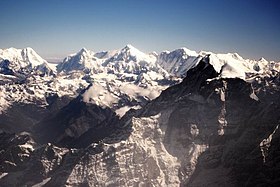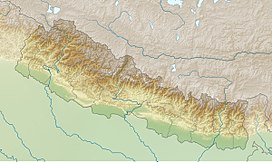Gauri Sankar
| Gauri Sankar | |
|---|---|

Gaurishankar (right)
|
|
| Highest point | |
| Elevation | 7,134 m (23,406 ft) |
| Prominence | 1,600 m (5,200 ft) |
| Listing | Ultra |
| Coordinates | 27°57′12″N 86°20′09″E / 27.95333°N 86.33583°ECoordinates: 27°57′12″N 86°20′09″E / 27.95333°N 86.33583°E |
| Naming | |
| Translation | The Goddess and her Consort (Sanskrit) |
| Geography | |
| Location | Nepal–China (Tibet) |
| Parent range | Rolwaling Himal |
| Climbing | |
| First ascent | May 8, 1979 by John Roskelley and Dorje Sherpa |
| Easiest route | snow/ice climb |
Gaurishankar (also Gauri Sankar or Gauri Shankar; Devanagari गौरीशंकर; Tibetan: Jomo Tseringma;) is a mountain in the Himalayas, the second highest peak of the Rolwaling Himal, behind Melungtse (7,181m). The name comes from the Hindu goddess Gauri, a manifestation of Durga, and her Consort Shankar, denoting the sacred regard to which is afforded it by the peoples of Tibet and Nepal. The Buddhist Sherpas call the mountain Jomo Tseringma. The Nepal Standard Time (GMT+05:45) is based on the meridian of this mountain peak.
Gaurishankar lies near the western edge of the Rolwaling Himal, about 100 kilometres (62 mi) northeast of Kathmandu. (It is almost directly between Kathmandu and Mount Everest, and is visible from Kathmandu.) To the west of the peak lies the valley of the Bhote Kosi, the western boundary of the Rolwaling Himal. To the north lies the Menlung Chu, which separates it from its sister peak Melungtse. To the south lies the Rolwaling Chu, which leads up to the Tesi Lapcha pass, giving access to the Khumbu region. It is in Dolakha District.
The mountain has two summits, the northern (higher) summit being called Shankar (a manifestation of Shiva) and the southern summit being called Gauri (a manifestation of Shiva's consort). It rises dramatically above the Bhote Kosi only 5 km away, and is protected on all sides by steep faces and long, corniced ridges.
The first attempts to climb Gauri Sankar were made in the 1950s and 1960s but weather, avalanches and difficult ice faces defeated all parties. From 1965 until 1979, the mountain was officially closed for climbing. When permission was finally granted in 1979, an American-Nepalese expedition finally managed to gain the top, via the West Face. This was a route of extreme technical difficulty. The permit from the Nepalese Ministry of Tourism stipulated that the summit could only be reached if an equal number of climbers from both nations were on the summit team. John Roskelley and Dorje Sherpa fulfilled that obligation.
...
Wikipedia

